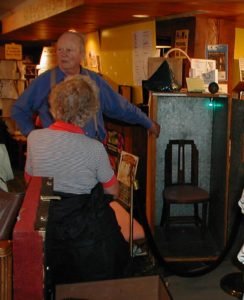In his 1971 memoir, Me and the Orgone, Orson Bean recounted his life-changing experience undergoing orgone therapy, a body-mind psychotherapy developed eighty years ago by Austrian-born psychiatrist Wilhelm Reich. Reich and orgone played a role in my life, too, beginning in the 1970s when I embarked on an eventually abandoned plan to become a psychotherapist.
While studying Gestalt therapy and bioenergetics at Associates for Human Resources (AHR) in Concord, Massachusetts, I learned that these therapies are partly derived from different phases of Reich’s career. As a psychoanalyst in the 1920s, Reich developed a new approach to talking therapy called character or resistance analysis. Fritz Perls, the founder of Gestalt therapy, was both a patient and student of Reich during that period.
During the 1930s, Reich originally called the energy of the body bio-electricity, then bioenergy, and, finally, orgone. In that period, he broke with psychoanalysis and developed orgone therapy. One of his later patients, Alexander Lowen, based his own body-mind therapy on Reich’s work, calling it bioenergetics.
Reich advocated treating the patient’s resistance in therapy by taking the side of the resistance. The meaning of this technique became clear when I took a course from Myron Sharaf, a professor of psychology who had been a patient and student of Reich. In each class, he worked with students in one-on-one demonstrations of his therapeutic approach. When my turn came, I confessed that I was not sure I was up for it.
“It’s okay,” he said. “You don’t have to do anything today. You have all the time in the world.”
Of course, I did not have “all the time in the world.” This was the penultimate class, and if I did not work with Sharaf now, when would I? When would I ever work on myself with anyone? I suddenly felt regret for lost opportunities past, present and potential, and I began to weep. It had been a source of frustration to me—and all prior therapists—that I do not express my feelings easily; yet Sharaf got me to express them in ten seconds flat.
Before he immigrated to the United States in 1939, Reich spent a decade experimenting in physiology, biology and physics. He proposed that orgone energy is not only in the body but everywhere, that, rather than being made up of inanimate matter and energy, the universe is infused with living energy.
Isaac Asimov suggested that there are two kinds of science heretics: The endo-heretic challenges orthodoxy from within a field where he is qualified, while the exo-heretic challenges orthodoxy in a field where he is not credentialed. Most science heretics are one type or the other, but Reich was both.

He was an endo-heretic within psychoanalysis, but he became an exo-heretic in biological research and physics where his credentials were progressively shakier. In and of itself this might not make his ideas invalid, but his early attempts to communicate his exo-heretical ideas failed and Reich was rejected even by those in his own field. Eventually, he stopped trying to build bridges between his work and mainstream science.
In one experiment, Reich lined the interior of a room with sheet metal and reported that this increased the effects associated with orgone energy. It occurred to him that he could make smaller enclosures to concentrate orgone. These “orgone accumulators” were used in both scientific research and medical treatment. Reich sold accumulators to the public and published directions for making them. He also prescribed the accumulator to patients, but admitted to them that they were experimental. Largely for this reason, he gave away more accumulators than he sold, according to Sharaf.
In 1954, the U.S. Food and Drug Administration brought an injunction against Reich, claiming that the accumulator was a fraudulent medical device. When one of his associates sold an accumulator in violation of the injunction, both he and Reich went to federal prison where Reich died in 1957 at age 60. A troubling sequela of the injunction was that it included Reich’s books in the ban on the grounds that they were “labeling” for the accumulator. Troves of Reich’s published books on psychology and politics ended up being burned by the government. The few books that were re-published during the early 1960s were printed despite fears that the FDA might intervene in their publication, even when they had never been about the accumulator. But by the end of the 1970s, several books were in print again, including some that explicitly discussed the accumulator.
In 1982, when I lived in Sonoma, California, I built an orgone accumulator to specifications I found in one of Reich’s books. Its wooden frame was phone-booth-shaped with an outer surface made of gypsum board, and the inside was lined with sheets of zinc-coated steel. Between these two surfaces, I put alternating layers of cotton batting and steel wool. I left space above and below the door for circulation and placed a small wooden stool inside. The accumulator was not much taller than five feet with little more than enough width for elbow room. I kept it on a porch until I had to dismantle it when I moved.
When I got married, my wife, Roseann, urged me get rid of the disassembled accumulator, which was just taking up space. She wanted me to toss it, but I put an ad in the classifieds. In less than two weeks, a man came by to see it, and I assembled the accumulator for him.
I had not yet put the door on when the man put one hand inside the accumulator and the other outside and said, “It’s working.”
“It is?” I was surprised—I who had made it and once used it. I put my hands in the same positions he had. The palm of my hand inside the devise felt something gossamer-y—similar to static electricity but softer—coming off of the inner wall. Remembering my role as salesman, I said, “And that’s with the door off.”
“I’ll take it,” said my customer.
Roseann never got over the fact that someone actually bought the accumulator.

Share this post with your friends.


The Reich Museum mentioned in the caption of the picture is located just outside of Rangeley, Maine. The author visited the museum in 1980.